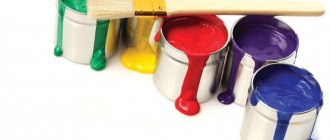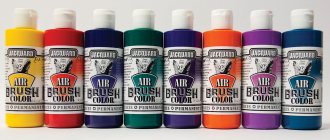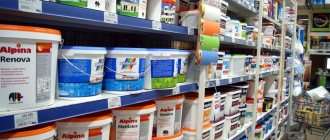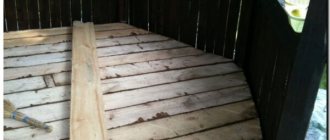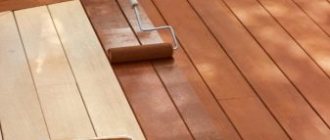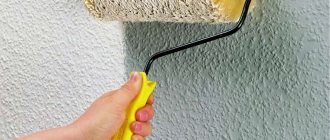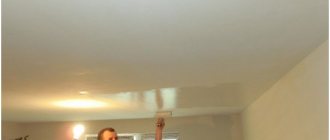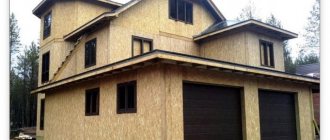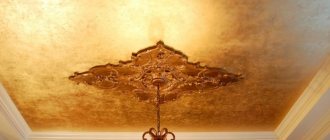The question of durable, high-quality painting of a wooden fence is relevant for many owners of both small country houses and large houses. How to paint a wooden fence? It would seem that everything is simple - I bought good paint, the necessary equipment, got ready to work and paint calmly. However, the situation is not too complicated and easy. Wood does not have excellent resistance to numerous adverse factors, which determines the need for special processing.
Why should you paint a wooden fence?
The nuance with wood is its porous microstructure, regardless of the type of wood. This property favors rapid impregnation with moisture from the outside. The structural fibers eventually become wet and the process of rotting begins. In addition, if there are rapid temperature changes, the wood fence material will become saturated with moisture and may crack as a result of water entering and expanding inside the fibers as the temperature drops.
Long-term exposure to the sun also has a negative effect on unpainted boards. For this reason, an unpainted wooden fence will slowly begin to dry out in time, and this will inevitably destroy it over time.
Insects, moss and mold pose a very serious danger to wooden fencing structures. If a wooden fence is left untreated for a long time, this will certainly affect it in the form of mold or moss, and wood being eaten away by bugs.
Considering the considerable cost of a wooden fence, it is necessary to process it in a timely manner, thereby increasing its service life and appearance.
Painting concrete fences
Finishing of concrete fencing structures
Concrete fences, despite their solid shape, are destroyed more quickly than wooden or metal ones. Moisture and dirt regularly enter the concrete structure, destroying the surface. Therefore, concrete surfaces must be painted.
For concrete surfaces, dispersion types of dyes that are resistant to environmental influences are better suited. In this case, you need façade acrylic paint applied to the primer layer. Acrylic paints for concrete are also sold in bottles. Applying the coloring composition in this way greatly simplifies the process.
Coatings that protect wood
Over a considerable period of varied use of wood structures, people have developed and tested many options for the protective treatment of this material. In the past, the most effective techniques were to coat the lumber with tar or resin. Nowadays, special compositions manufactured by industry are used for this.
The entire range of tread coatings, widely represented on the market, is divided into three basic types:
- oils;
- varnishes;
- paints.
The first two coating options leave the texture and color of the wood almost unchanged, but coloring compositions can significantly transform the entire appearance of the fence. This is preferable in most cases, so let’s look at this issue in more detail.
Important! When purchasing paints and varnishes, be sure to immediately select antiseptic compositions for wood for pre-treatment!
Let’s try to figure out which coloring composition is best to express preference so that a wooden fence gains attractiveness and, most importantly, durability.
How to paint a wooden fence for a long time - choose paint
To ensure that the painting of wooden structures is characterized by durability and quality, coloring compounds intended for finishing facades are always used. These coatings perfectly withstand the negative influence of most external destructive influences.
Good paint and varnish materials are distinguished by their resistance to ultraviolet rays, as well as the preservation of their original appearance, color saturation and brightness for a long time. Paints used in accordance with the instructions, made in factories, in accordance with the current GOST, last a minimum of 5.7-6 years.
To calculate the required quantity, use the included manufacturer's instructions. Special data is indicated on the packaging - hiding power parameters. They are designed for single-layer application of material to a surface of one square meter. This means you need to calculate (approximately) the area of the fence, always taking into account the ends of the boards. The final amount of paint and varnish material will be determined subject to the application of two layers of protective coating.
Explanation! 2 layers are the minimum standard for the initial coating of wood with coloring compounds. Of course, you can make more layers!
Exterior paints are divided into three categories depending on their main component:
- oil;
- acrylic;
- alkyd;
- water-based paint
Each of these paints is characterized by a set of distinctive features that must be taken into account when purchasing. Let's analyze each group.
Alkyd coatings
First of all, this material has a very reasonable price. This factor determines their greatest demand and popularity in the Russian market. A special advantage of paints of this type is the formation of a thin hydrophobic film, which significantly improves the protective qualities of the applied coating.
Other advantages include good frost resistance. Therefore, alkyd paint can be actively used in places where climatic conditions are the most unfavorable.
However, such a coating has many negative aspects, among which the most significant is the high drying speed. As a result, only a small amount of the substance penetrates the wood. Despite its demand and popularity, alkyd coating can hardly be called durable.
Paints based on polyester resins are extremely demanding on the condition of the surfaces being painted. They should be dry, clean and very smooth. If you apply a dye to wood that is not sufficiently dried, peeling, cracks, shedding and swelling will soon appear.
On average, one layer of the coloring composition dries completely in 9-10.5 hours under normal conditions.
Acrylate (acrylic) coatings
Acrylic-based paints are most widespread in European countries. This coating is universal, as it is ideally suited for the surfaces of metals, wood and other building materials.
It is important that any acrylic paint is absolutely environmentally safe, since it is necessarily made from acrylates (vinyl polymers) and ordinary water - that is, from natural components. This feature, on the other hand, determines the insufficient resistance of this material to mold fungi. Therefore, you need to carefully prepare the fence immediately before painting.
When choosing a material for painting a wooden fence, you should choose acrylic paint, as it is incredibly easy to use. The composition is applied without problems with a spray gun, any roller or a simple brush. The paint dries quickly. It can last up to 9-11 years - it all depends on the number of layers applied.
Nuance! Acrylic paint cannot be stored at subzero temperatures. It will collapse and fall apart into different fractions, which subsequently will not be able to be homogenized again!
Oil paints
In fact, oil paint is a finishing material that is not produced in Western and overseas countries. But, it is still consistently produced by the domestic chemical industry.
If we consider the option of using oil paint as a coating for a wooden fence, then a certain duality arises here.
On the one hand, such material very deeply and reliably impregnates the boards, protects well from moisture, and prevents mold from developing or insects that destroy wood fibers. However, the other side is very unfavorable.
Let's highlight the negative points point by point:
- the highest flammability in all forms;
- toxicity and having a characteristic persistent odor. All this is due to drying oil, which is used as a base component;
- difficulty of use. Often, paint is sold in the form of a concentrated substance that must be diluted with drying oil. Then this mixture has to be stirred for a long time until completely homogeneous;
- each layer takes more than a day to dry, and due to the good, but uneven absorption of the composition into the wood, you will need to apply at least 2-3 layers for uniform painting. The following disadvantage follows from this;
- the high cost of coating a wooden fence with oil paint - high consumption of material plus solvent;
- it will not be possible to subsequently use another type of paint, since oil paint is incompatible with other compositions. You will have to remove the dried layers and clean the wood in order to paint it, say, with an alkyd material. This is a huge effort.
Advice! You can reduce costs if you pre-soak the boards with drying oil and let it dry. Then you can get by with one or two layers of paint!
In general, oil paint is the worst possible option.
Water-based paint
Water-based emulsion is a good option when the question arises of how to paint a wooden fence. However, this paint is not as durable as other options and has restrictions on application - you need to paint with this paint in warm weather. Otherwise, you risk poor-quality painting, peeling and poor adhesion.
Rust removal
On the surface of a metal fence, as a result of natural factors (rain, sun rays), rust and a light green coating appear, that is, a patina, creating an antique look. Before starting painting, it is necessary to remove rust and patina, because they will soon begin to penetrate the paintwork and can lead to peeling of the paint.
Before painting an iron fence, so that it does not rust later, it is necessary to carry out anti-corrosion treatment. You can remove rust yourself. If the rust has penetrated too deeply, removing plaque at home is too difficult, and you will have to pay for cleaning at a specialized workshop.
You can remove rust yourself using a rust remover, for example:
- Fosol,
- Epoxy,
- Rust filler.
In more complex cases, the work is done using a grinding machine with a grinding wheel installed, as shown in the photo.
If corrosion is noticed in time, the rust can be removed using a wire brush. This is possible if the rust creates only a superficial coating that is not difficult to remove.
For cleaning you can use:
- wire brush,
- sandpaper (120-240).
There is no need to clean the surface down to bare metal. All traces of rust and layers of paintwork should be removed if they could potentially come off along with the new paint that you intend to use for painting.
Paint Application Tools
Typically, the following tools are used to apply paint to a fence:
- brush;
- roller;
- spray;
How to paint a wooden fence cheaply and for a long time? Of course, the cheapest tools for painting will be brushes or a roller. What is the best way to apply paint? It all depends on the structure of the boards that make up the fence: if the boards are well processed and the surface is relatively flat, then it will be faster to paint the fence with a roller; if the surface of the boards is poorly processed and not very smooth, then it is better to use a brush. You can also combine these two tools when applying.
Tools for painting a wooden fence
A pneumatic spray gun is a more expensive application tool, but will allow you to paint the entire fence area evenly without streaks.
Metal Fence Colors and Decorative Effects
There are no problems with choosing paint colors for fences. All manufacturers of paint and varnish products offer a large selection of colors. Right in the store you can use the computer color selection service and give the paint the desired shade.
The painted surface of the fences can be shiny, semi-matte or matte. Paints that impart various effects to the metal surface are popular. For example, paint can imitate faint traces of deformation (as after blows with a hammer), an aged or cracked surface.
Stylish aging of a metal fence
Patination gives decorative fences an interesting look. The effect is of antiquity. For patination, special paints with different shades of green are used. Also, the effect of antiquity can be achieved by painting metal with paints that imitate rust or give it a sheen of copper, gold or silver.
The paint is not applied to the entire surface, but only to certain fragments of the fence. This is done two days after applying the main finishing coat. The paint is mixed and a brush, foam rubber or cloth is soaked in it, then lightly smeared, for example, on a piece of board. When the paint on the brush or cloth dries slightly, wipe the metal parts to be painted with it.
The patination effect is best seen on a surface previously painted with graphite-colored paint. You can brush fences coated with this paint with a hard-bristled brush (two to three days after painting).
Patination effect
The fencing bars look like ancient forging. This effect can be achieved using modern paints.
It is fashionable to combine the color of a metal fence with elements of the facade of the house - drainpipes, clinker, roof
Metal fence
The metal mesh is coated with zinc and then polymer. This double coating is very reliable. No need to paint the fence
Metal grid
Forged decorative fencing elements require regular maintenance. In this case, in addition to paint, you must also use a rust remover.
Forged fence element
To protect metal products from corrosion, they need to be painted.
Corrosion on a metal fence
Metal fencing will last longer if its maintenance is timely and regular. The mesh needs to be painted every 4-5 years
Metal grid
Forged metal balustrade elements are traditionally painted black. Beautiful and discreet classic
Balustrade elements
Paints with various decorative effects are popular. Here the surface is shiny, but it seems like the metal was tapped with a hammer
Paints with decorative elements
Metal elements protected from precipitation do not need to be painted often
Metal elements
Rust resistance test
To find out how effectively paint will protect metal from rust and how long it will last, you can conduct the following experiment (it is recommended to carry out the test on several types of paint). Prepare a small metal object and paint it according to the manufacturer's instructions.
After the paint has completely dried (after a few days), place the painted object in a jar with a solution of kitchen salt (approximately 10 tablespoons of salt per 1 liter of water). After a few days, traces of rust will appear on the metal. The longer the coating resists corrosion, the better the paint protects the metal.
Prepare a small metal object and paint it following the instructions class=”aligncenter” width=”800″ height=”630″[/img]Put the painted object in a jar with a solution of kitchen salt, and after a few days we observe the result.
Tips for Painting a Metal Fence
- Do not use a roller to prime metal surfaces. When it is used, air is pumped deep into the base, along with which moisture can penetrate there. And this is the first step towards corrosion.
- Painting a metal surface with a spray gun produces a smoother, shinier finish than using a brush or roller.
- Do not paint a metal surface if its temperature exceeds 40°C.
- Work can be carried out at air temperatures above 5°C and relative humidity up to 80–85%.
- Do not add too much solvent to the paint - this reduces the quality of the work performed, since the dissolved paint may form too thin a layer.
How to paint a wooden fence correctly?
When you have decided what to paint a wooden fence with and what to apply the paint with, you also need to think about what to prime the fence with before painting. The fence primer will improve the adhesion of paint to wood and impregnate the boards, thereby increasing their service life. Therefore, be sure to apply a primer before painting and let it soak in.
It is best to paint a fence that has not yet been installed by placing it on the ground in a horizontal position, this way the paint will absorb better. Regardless of whether you are painting an already installed fence or not, you need to place newspapers, polyethylene or other material under it on which the paint will flow. This way you will avoid paint contaminating your tools, as well as the surrounding area - yard, asphalt, plants, etc. This will also help prevent plants and soil from sticking to the freshly applied layers of paint.
The paint must be applied from the top of the wooden board, gradually going down. As mentioned above, in order to paint a wooden fence for a long time it is necessary to apply at least two layers of paint.
Properly preparing boards for painting
Before painting, a wooden fence must be prepared accordingly. This is done like this:
- the wood is dried and all damaging factors (fungi, mold, moss, etc.) are removed from it. Then a thorough impregnation with special antiseptics is carried out. These solutions are usually sold in construction stores along with paint;
- determine the presence of resin pockets and leaks. When the resin content of the wood is significant, it must be treated with ammonia or cellulose solvent. This procedure cannot be neglected, otherwise the paint will not adhere to the resinous areas properly;
Recommendation! To prevent resin discharge from fresh lumber, it is advisable to treat it with a shellac solution!
- align areas with knots, which are found on almost every board. Sanding with sandpaper is usually sufficient. After sanding, it is necessary to wet a piece of rag with acetone solvent and thoroughly wipe the surface to remove dust particles and the smallest sawdust;
- Before painting an old, previously painted fence, be sure to remove layers of the old coating. A grinder or an industrial hair dryer is used for this;
- if there are unevenness on the fence boards (chips, fallen knots, etc.), then they are filled with putty, sanded and the “patch” area is cleaned;
- new lumber, as a rule, is degreased with a nitro solvent and then used to make a fence.
What type of paint to choose
To properly paint a metal fence, you need to use paintwork materials that are resistant to temperature changes and have a level of adhesion sufficient to firmly secure the coating to the product.
The following criteria exist for selecting a suitable mixture:
- barrier material;
- climatic conditions in which the fence will be used;
- financial capabilities of the buyer.
To paint galvanized metal fences, you can use acrylic or alkyd paint (these compositions apply to almost any material). The ferrous metal fence can be well painted with anti-corrosion or oil-based material. Non-ferrous metals should be coated with paints based on epoxy resin or polyurethane.
